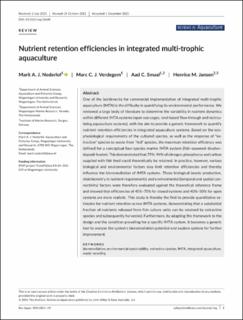| dc.description.abstract | One of the bottlenecks for commercial implementation of integrated multi-trophic aquaculture (IMTA) is the difficulty in quantifying its environmental performance. We reviewed a large body of literature to determine the variability in nutrient dynamics within different IMTA systems (open sea-cages, land-based flow-through and recirculating aquaculture systems), with the aim to provide a generic framework to quantify nutrient retention efficiencies in integrated aquaculture systems. Based on the eco-physiological requirements of the cultured species, as well as the response of “extractive” species to waste from “fed” species, the maximum retention efficiency was defined for a conceptual four-species marine IMTA system (fish–seaweed–bivalve–deposit feeder). This demonstrated that 79%–94% of nitrogen, phosphorus and carbon supplied with fish feed could theoretically be retained. In practice, however, various biological and environmental factors may limit retention efficiencies and thereby influence the bioremediation of IMTA systems. These biological (waste production, stoichiometry in nutrient requirements) and environmental (temporal and spatial connectivity) factors were therefore evaluated against the theoretical reference frame and showed that efficiencies of 45%–75% for closed systems and 40%–50% for open systems are more realistic. This study is thereby the first to provide quantitative estimates for nutrient retention across IMTA systems, demonstrating that a substantial fraction of nutrients released from fish culture units can be retained by extractive species and subsequently harvested. Furthermore, by adapting this framework to the design and the condition prevailing for a specific IMTA system, it becomes a generic tool to analyse the system's bioremediation potential and explore options for further improvement. | en_US |
